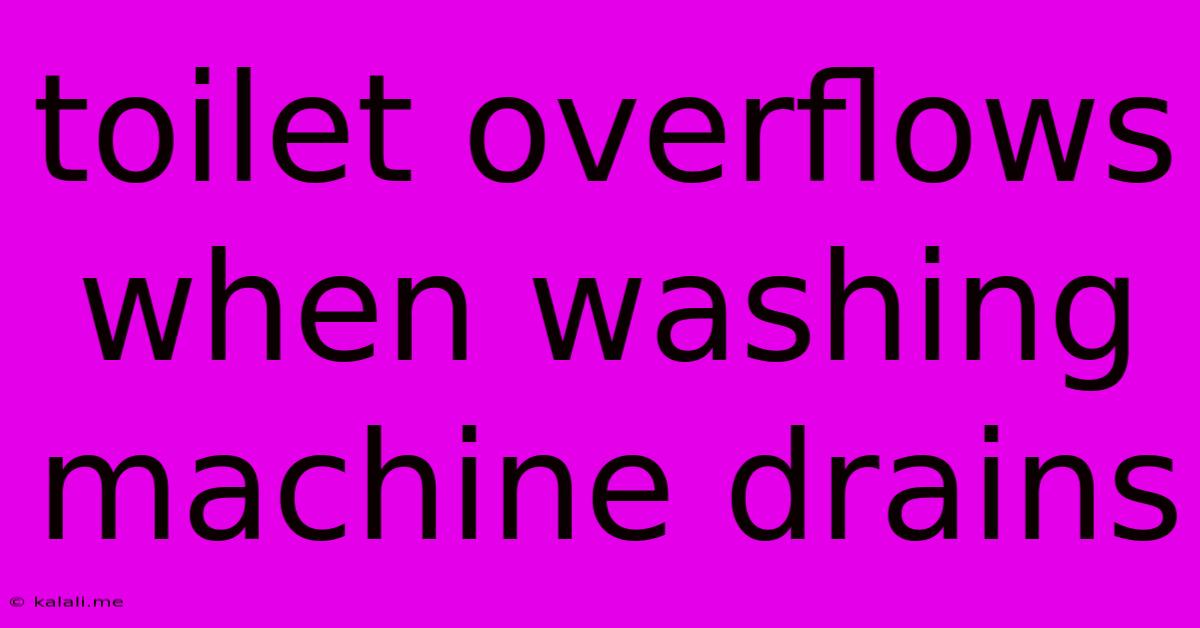Toilet Overflows When Washing Machine Drains
Kalali
Jun 08, 2025 · 3 min read

Table of Contents
Toilet Overflows When Washing Machine Drains: Troubleshooting and Solutions
A gurgling toilet during washing machine drainage is a common household plumbing problem, often escalating into a full-blown overflow. This isn't just inconvenient; it can lead to costly water damage. This article explores the causes of this frustrating issue and provides practical solutions to prevent future occurrences. Understanding your plumbing system is key to resolving this problem quickly and effectively.
Why Does My Toilet Overflow When the Washing Machine Drains?
The most common culprit is a blocked vent stack. The vent stack is a crucial part of your plumbing system, allowing air to enter the drainage system, preventing siphoning and ensuring proper drainage. When this vent becomes obstructed – by debris, bird nests, or ice – pressure builds up in the drain lines. This pressure can force wastewater back up into the lowest fixture in the system, often the toilet.
Other potential reasons include:
- Clogged drain lines: A significant blockage in the main drain line can also cause pressure to build up, leading to backflow into the toilet. This often requires more significant plumbing intervention.
- Improper plumbing installation: In some cases, the plumbing system itself might have been incorrectly installed, leading to inadequate venting or a predisposition to backups.
- Low water pressure: Although less common, extremely low water pressure can sometimes contribute to drainage issues. The reduced pressure may not be enough to effectively flush waste down the drain, causing a buildup and potential overflow.
- Tree root intrusion: Older homes with aging pipes might experience tree root intrusion into the drain lines, causing significant blockages.
Troubleshooting Steps:
- Check the vent stack: Inspect the vent stack on your roof or side of the house. Look for any obvious obstructions such as leaves, debris, or nests. If you find anything blocking it, carefully remove it. This often resolves the problem immediately.
- Run hot water: Before running the washing machine, run hot water in a sink or tub located on the same plumbing line. This can sometimes help clear minor blockages.
- Check the washing machine drain hose: Ensure that the drain hose from the washing machine is properly secured and not kinked or clogged. A poorly positioned hose can restrict drainage and contribute to backflow.
- Check for clogs in other drains: Run water down several drains (kitchen sink, bathroom sink, shower) to determine if there is a general drainage problem. If other drains are slow, you likely have a more significant blockage in your main drain line.
- Inspect the toilet flapper: While less likely the direct cause, a faulty toilet flapper can contribute to water level issues that could exacerbate overflow during periods of increased drainage pressure. Ensure the flapper seals properly.
Solutions and Preventative Measures:
- Call a plumber: If the problem persists after trying these troubleshooting steps, it's best to call a qualified plumber. They have the tools and expertise to diagnose and address more complex plumbing issues, such as significant clogs in the main drain line or problems with the vent stack.
- Regular maintenance: Regularly check and clean your drain lines to prevent future clogs. Consider using drain cleaning solutions (but use cautiously and according to instructions) or a plumber's snake to clear minor blockages.
- Preventative plumbing: If you're building or renovating, ensure that your plumbing system is properly designed and installed with adequate venting to minimize the risk of backflow.
Conclusion:
A toilet overflowing during washing machine drainage is a plumbing problem that requires prompt attention. By understanding the potential causes and following the troubleshooting steps outlined above, you can often resolve the issue yourself. However, for persistent or severe problems, professional help from a qualified plumber is recommended to prevent costly water damage and ensure the long-term health of your plumbing system. Remember, preventative maintenance is key to avoiding this frustrating situation in the future.
Latest Posts
Latest Posts
-
Bg3 Speak To The Tieflings Last Light
Jun 09, 2025
-
Who Is The Witch Of The Lion And The Wolf
Jun 09, 2025
-
What Does Pie Stand For In Quotes
Jun 09, 2025
-
Do Facetime Calls Show Up On Phone Bill
Jun 09, 2025
-
How Do You Hang A Picture On A Concrete Wall
Jun 09, 2025
Related Post
Thank you for visiting our website which covers about Toilet Overflows When Washing Machine Drains . We hope the information provided has been useful to you. Feel free to contact us if you have any questions or need further assistance. See you next time and don't miss to bookmark.